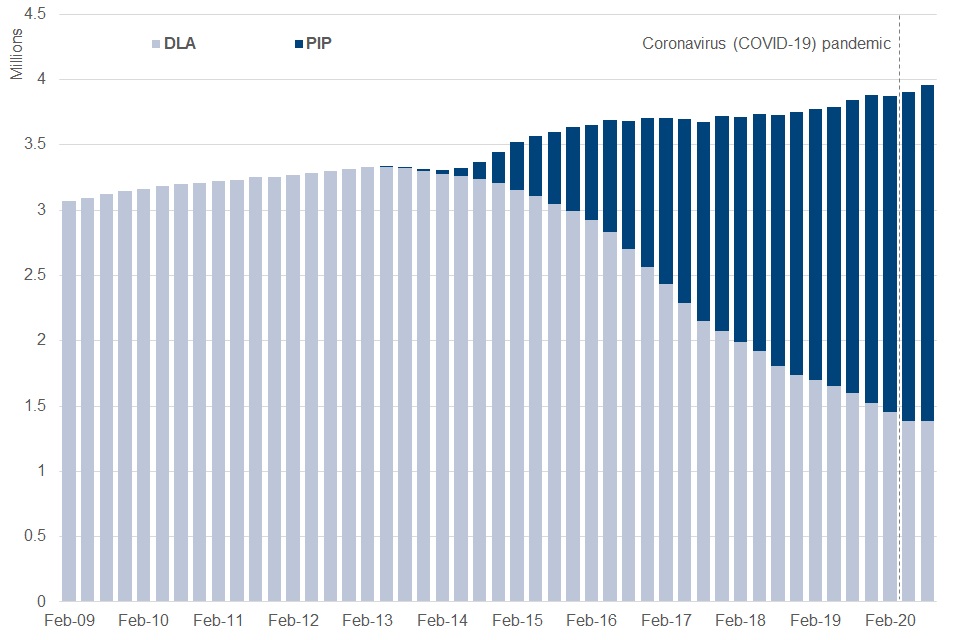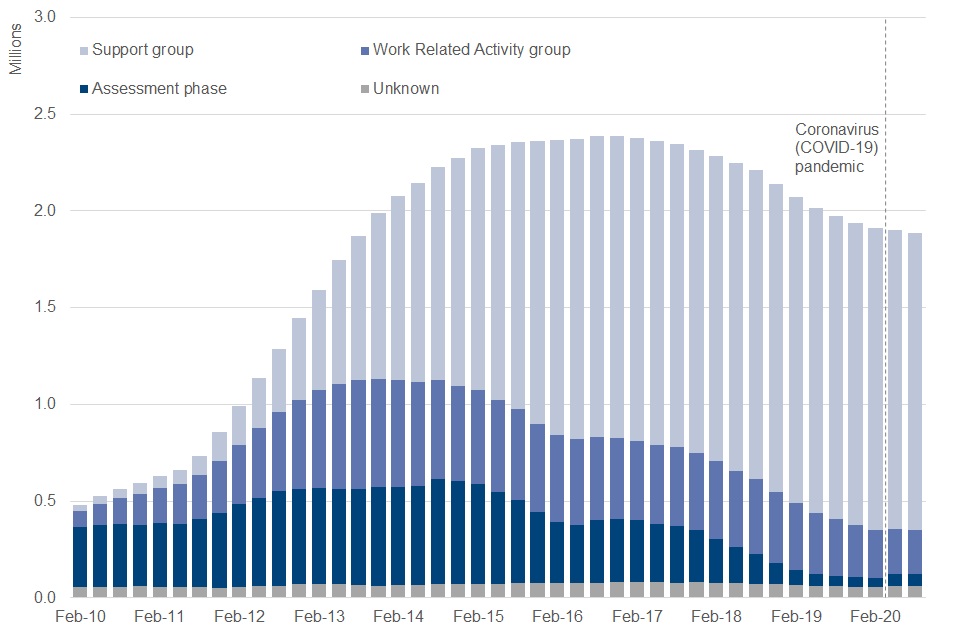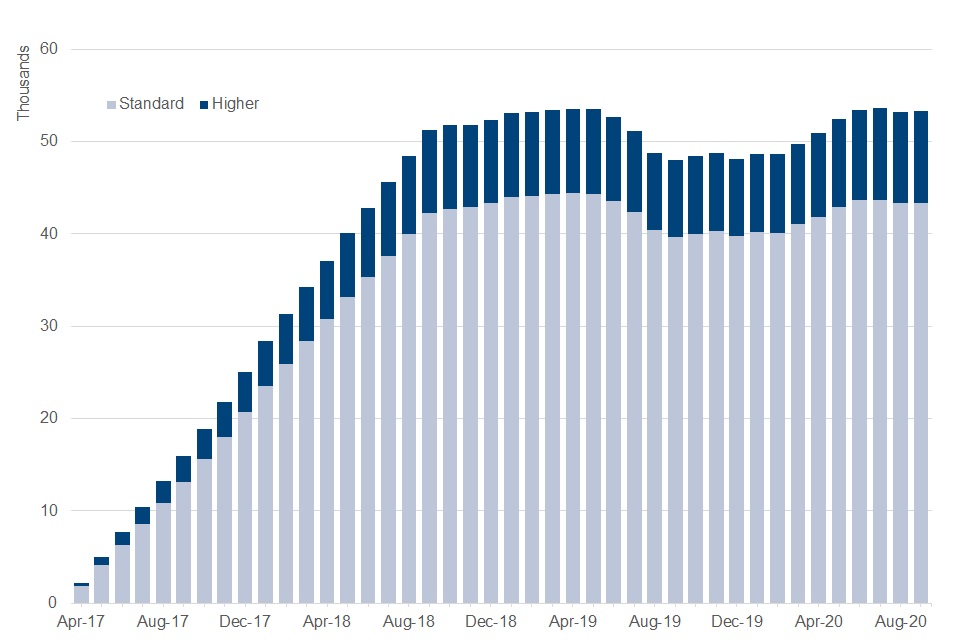DWP benefits statistics: February 2021
Published 23 February 2021
The latest release of these statistics can be found in the benefit statistics collection.
This is a summary of the National Statistics about the benefits administered by the Department for Work and Pensions (DWP).
1. Headlines
The main headline figures for the DWP benefits in this report
The age at which people can start claiming State Pension is rising.
- In the year to August 2020 the number of people receiving the State Pension fell by 1.6% to 12.4 million
The time period for this release was affected by the coronavirus (COVID-19) pandemic. Additionally, Universal Credit has been replacing some older-style Working Age benefits.
- Jobseeker’s Allowance increased to 340,000 claimants in the year to August 2020, an 85% increase
- Employment and Support Allowance remained at 1.9 million claimants in the year to August 2020
- Housing Benefit fell to 3.0 million claimants in the year to November 2020
- Income Support fell to 280,000 claimants in the year to August 2020
The latest Universal Credit Official Statistics show:
- there were 5.9 million Universal Credit claimants at December 2020
People can claim more than one DWP benefit at a time. Experimental benefit combination statistics show:
- the total number of people claiming DWP benefits was 22.8 million in the year to August 2020
- 12.5 million were Pension Age, 9.5 million were Working Age, and the remainder children claiming Disability Living Allowance
- 30% of State Pension Age claimants and 32% of Working Age claimants were claiming more than one benefit
DWP benefits by number of claimants at August 2020
| Benefit | Number of claimants |
|---|---|
| State Pension | 12,364,000 |
| Universal Credit | 5,571,000 |
| Housing Benefit | 3,046,000 |
| Personal Independence Payment | 2,572,000 |
| Employment and Support Allowance | 1,885,000 |
| Attendance Allowance | 1,532,000 |
| Pension Credit | 1,492,000 |
| Disability Living Allowance | 1,372,000 |
| Carer’s Allowance | 1,300,000 |
| Jobseeker’s Allowance | 337,000 |
| Income Support | 281,000 |
Source: DWP benefits statistics.
Figures for Universal Credit, Personal Independence Payments and Housing Benefit covering later time periods are available on Stat-Xplore.
2. What you need to know
This release covers DWP benefits in Great Britain. For most benefits covered in this release the time period covered is up to August 2020, however for Bereavement Support Payment, the period covered is up to September 2020, and for Housing Benefit and Universal Credit, the period covered is up to November 2020.
More detailed statistical tables covering all National Statistics benefits can be found using Stat-Xplore. This is an online tool that lets you create and download customised statistical tables, and view the results in interactive charts.
Figures for this release reflect the disruptions caused by the coronavirus (COVID 19) pandemic, which has led to some changes in operational procedures. Such changes were necessary to process claims while keeping customers and staff safe, while ensuring those eligible received their benefits. For more information on some of these changes see the background note.
The experimental Benefits Combinations statistics explores how benefits are claimed in combination for claimants of all ages. Benefit Combinations statistics now include Industrial Injuries Disablement Benefit claimants and Under 16 DLA claimants, alongside updates to its methodology. For more details see the Benefit Combinations methodology note.
For more information on how these statistics are produced, see our methodology statement and quality statement.
3. Pensions
State Pension
People receiving State Pension by scheme to August 2020

Source: DWP benefits statistics.
The overall State Pension caseload has been decreasing in recent years. There were 12.4 million people receiving State Pension at August 2020, a decrease of 200,000 on a year earlier. Since December 2018, the State Pension Age has been raised above 65 for both men and women, resulting in fewer new claims. At August 2020, the minimum State Pension Age was 65 years and 10 months, reaching 66 years in October 2020.
The new State Pension (nSP) scheme was introduced for people reaching State Pension Age from 6 April 2016. At August 2020 there were 1.6 million people receiving nSP, an increase of 340,000 on a year earlier.
New State Pension
Comparison of average weekly amounts of State Pension by scheme and gender at August 2020
| State Pension scheme | Male | Female |
|---|---|---|
| New State Pension | £166.22 | £159.26 |
| Pre-2016 State Pension | £169.29 | £141.69 |
Source: DWP benefits statistics.
At August 2020 the average (mean) weekly payment for people receiving State Pension was £154.74, an increase of £6.12 since August 2019.
The nSP average (mean) weekly payment was £164.10 (including any Protected Payments).
The introduction of nSP has evened out some of the gap between the average weekly payments for men and women, as women tend to get more under the new scheme than under the Pre-2016 scheme. However, due to earlier timetabled increases in women’s State Pension Age fewer women have joined the new scheme than men.
Pension Credit
At August 2020, there were 1.5 million people receiving Pension Credit (PC), representing a total of 1.7 million beneficiaries including partners.
A comparison of Pension Credit recipients by payment type and gender at August 2020
| Type of Pension Credit | Male | Female |
|---|---|---|
| Guarantee Credit only | 260,000 | 490,000 |
| Savings Credit only | 94,000 | 140,000 |
| Both Guarantee and Savings Credit | 170,000 | 330,000 |
Source: DWP benefits statistics.
There were 82,000 fewer recipients against the previous year. Nearly two thirds (65%) of people getting PC were women. The downward trend in overall PC caseload is due to the raising of the State Pension Age and the introduction of nSP in April 2016, among other factors.
4. Housing
Housing Benefit
Housing Benefits claimants by age group at November 2020

Source: DWP benefits statistics.
At November 2020, there were 3.0 million recipients of HB, a decrease of 340,000 compared to the previous year. The number of people receiving Housing Benefit (HB) will continue to fall as Universal Credit (UC) replaces HB for Working Age recipients. At November 2020, there were 1.1 million Pension Age and 1.8 million Working Age recipients. By comparison, 2.8 million households had a housing element as part of their UC assessment, of which 2.5 million were in payment.
Housing Benefit claimants by sector at November 2020
| Sector | Number of claimants |
|---|---|
| Private Rented Sector | 720,000 |
| Social Rented Sector | 2,200,000 |
Source: DWP benefits statistics.
76% of HB recipients (2.2 million) were tenants in the Social Rented Sector and 24% were in the Private Rented Sector (720,000).
In April 2020 Local Housing Allowance rates were raised in response to the coronavirus (COVID-19) pandemic. Average HB awards in the private rented sector have gone up by £10.73 as a result in the year to November 2020. The average weekly award for private rented claims was £130.50 at November 2020. This compares to £100.75 for the social rented sector.
As at November 2020, 14% (250,000) of Working Age HB recipients had a reduction to their weekly award amount due to the Removal of Spare Room Subsidy scheme. This is where tenants in social housing whose accommodation is deemed to be larger than they need may lose part of their HB award. The average reduction amount was £15.87.
5. Health, disability and care
Personal Independence Payment (PIP) and Disability Living Allowance (DLA)
There were 4.0 million people claiming either PIP or DLA at August 2020, an increase of 120,000 during the last year.
The number of people claiming Personal Independence Payment or Disability Living Allowance to August 2020

Source: DWP benefits statistics.
Since 2013, working age adults have been moving from DLA to PIP. This has led to an increase in the number of people claiming PIP and a decrease in the number of people claiming DLA over time.
At August 2020, there were 2.6 million people claiming PIP, and 1.4 million people claiming DLA. The number of people claiming PIP rose by 330,000 while DLA claims fell by 210,000 in the year to August 2020. Transfers from DLA to PIP were affected by the coronavirus (COVID-19) pandemic – see the background note for more details.
Of the 1.4 million DLA claimants, a small number (14,000) were entitled to DLA but did not receive any payment. For example, payments can be temporarily suspended if the claimant is in hospital.
Attendance Allowance
At August 2020, there were 1.5 million Attendance Allowance (AA) claimants, a decrease of 57,000 from August 2019. 1.4 million claimants were receiving a payment and 110,000 (7%) were entitled to the benefit but not receiving payment. As with DLA above, AA payments can be temporarily suspended for instance, if the claimant is in hospital.
Employment and Support Allowance
There were 1.9 million people on Employment and Support Allowance (ESA) at August 2020, a decrease of 91,000 over the last year.
Employment and Support Allowance claims by type to August 2020

Source: DWP benefits statistics.
Of the 1.9 million ESA claimants:
- 1.5 million are in the Support group
- 220,000 are in the Work-Related Activity group
- 65,000 are in the Assessment phase
- 780,000 ESA claimants are former IB cases who have been migrated
Over recent years, the number of ESA claims has been decreasing because UC has replaced ESA for new income-related claims on the grounds of incapacity. Over the last year, the number of ESA claims has decreased by 4.6% (91,000).
The Work Capability Assessment process for ESA has been affected by the coronavirus (COVID-19) pandemic. For more information see the most recent ESA Work Capability Assessment statistics.
Figures for other incapacity benefits are available on Stat-Xplore.
Carer’s Allowance
The total number of people claiming Carer’s Allowance (CA) at August 2020 was 1.3 million, the same as at August 2019.
Of the total number claiming Carer’s Allowance, 28% (360,000) were entitled to the benefit but do not receive payments.
Recipients of Carer’s Allowance in Scotland are eligible for Carer’s Allowance Supplement (CAS), which is payable once every 6 months.
CAS statistics are released by the Scottish Government.
6. Other working age benefits
The number of people claiming Income Support and Jobseeker’s Allowance to August 2020

Source: DWP benefits statistics.
Jobseeker’s Allowance
There were 340,000 people claiming Jobseeker’s Allowance (JSA) in August 2020. Between February 2012 and March 2020, the number of people claiming JSA fell overall, subject to seasonal variation, due to the introduction of UC. However, from March 2020, the economic disruption caused by the coronavirus (COVID-19) pandemic resulted in an increase in people claiming JSA. In August 2020, there had been a yearly increase of 150,000 people (85%) claiming JSA.
Universal Credit has been replacing income-based JSA since April 2013. The JSA scheme is now only open to contributory-based claims called New Style JSA. Data on the ethnicity of people claiming JSA has been affected during the coronavirus (COVID-19) pandemic. For more information see the background note.
Income Support
At August 2020, the total number of people claiming Income Support (IS) was 280,000, a decrease of 91,000 over the last year. Lone parents represent 57% of the number of people claiming IS, and carers represent 42%. The number of people claiming IS due to incapacity has now fallen to just 170.
Universal Credit is replacing IS. New claims to IS can now only be made if people currently receive the Severe Disability Premium, or where the premium was received within the last month and eligibility still exists.
Read the Alternative Claimant Count statistics to get a better view of the number of people claiming unemployment benefits. The experimental Alternative Claimant Count statistics cover the time period to November 2020 and therefore cover the coronavirus (COVID-19) pandemic.
Bereavement Support Payment
Bereavement Support Payment recipients by rate of payment at September 2020

Source: DWP benefits statistics.
At September 2020, there were 53,000 people claiming Bereavement Support Payment (BSP), an increase of 5,300 compared to September 2019. Of these, 43,000 (81%) were receiving the standard rate of BSP, while 10,000 (19%) were receiving the higher rate. The higher rate is paid to claimants entitled to Child Benefit. BSP was introduced in April 2017 and replaced Widowed Parents Allowance, Bereavement Allowance and the Bereavement Payment.
7. About these statistics
This is a summary of the latest National Statistics about the benefits administered by the Department for Work and Pensions (DWP). Data are released on a quarterly basis in:
- February
- May
- August
- November
This summary is released every February and August.
This publication was assessed by the Office for Statistical Regulation (OSR) in November 2021 and designated as a National Statistic pending publication of an action plan addressing the requirements for improvement made by the OSR. The action plan will be published in April 2021. The designation of National Statistic status is in accordance with the Statistics and Registration Service Act 2007 and signifying compliance with the Code of Practice for Statistics.
All of DWP’s statistics are National Statistics except:
- Personal Independence Payments (Official Statistics)
- Universal Credit (experimental statistics)
- Benefit Combinations (experimental statistics)
- Bereavement Support Payment (experimental statistics)
- Housing Benefit Flows (experimental statistics)
- Alternative Claimant Count (experimental statistics)
The statistics in this publication are affected by the introduction of Universal Credit. Universal Credit was introduced in April 2013 in certain pathfinder areas of North West England. Between October 2013 and December 2018, Universal Credit was progressively rolled out and is now available in every jobcentre across the country.
Universal Credit is replacing:
- Income-related Employment and Support Allowance
- Income-based Jobseeker’s Allowance
- Housing Benefit for Working Age claimants
- Income Support
- Working Tax Credit
- Child Tax Credit
Please see Universal Credit statistics for information on the number of people and households on Universal Credit.
Information on the following benefits is published separately:
- Benefit Sanctions statistics
- Industrial Injuries Disablement Benefit statistics
- Child Support Agency cases statistics
- Maternity Allowance statistics
Where to find out more
Find previous releases of this data.
More detailed statistical tables covering all National Statistics benefits can be found using Stat-Xplore. This is an online tool that lets you create and download customised statistical tables, and view the results in interactive charts.
Data tables are provided where data is not available on Stat-Xplore.
Read our newly updated policies and statements for background information on DWP National and Official benefit statistics, including some of the processes involved in developing and releasing these statistics.
Known issues, changes and revisions
During 2019, a new DWP computer system called “Get Your State Pension” came online to handle new State Pension claims. The number of State Pension claims being handled by the new system has been gradually building up, and at August 2020 there were approximately 760 cases in payment on the new system. We are developing new statistical datasets that will enable us include these cases in our published statistics in the near future. Once we have quality assured the new data we will announce further plans for their inclusion.
Bereavement Support Payment statistics have been fully reinstated and are available on Stat-Xplore as of November 2020. Housing Benefits Flows statistics have been moved to Stat-Xplore, also November 2020. They were previously released as spreadsheets.
Due to the 2020 Local Government Reorganisation, a new Unitary Authority, Buckinghamshire, was created at April 2020, replacing 4 Local Authority Districts. Datasets on Stat-Xplore showing Housing Benefit Administration by Local Authority have now been updated to reflect this change from April 2020. Residency-based geography breakdowns will be updated to reflect the above changes as part of a routine refresh in Spring 2021.
Further information about changes and revisions are in our background information note.
8. Contact information and feedback
For more information about this release, contact: alan.gibson@dwp.gov.uk.
DWP would like to hear your views on our statistical publications. If you use any of our statistics publications, we would be interested in hearing what you use them for and how well they meet your requirements. Email stats-consultation@dwp.gov.uk with your feedback.
You can also join the Welfare and Benefit Statistics community on StatsUserNet. DWP announces items of interest to users in this forum, as well as replying to users’ questions.
Lead statistician: Alan Gibson.
ISBN: 978-1-78659-301-6
